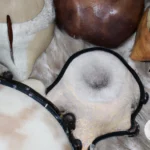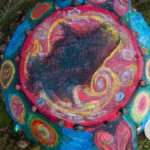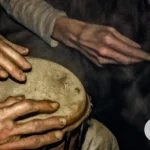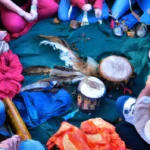Drumming has been used for centuries to bring people together in celebration, ceremony, and healing. Starting a drum circle in your community is a great way to connect with others, release stress, and tap into your creativity. It may seem daunting to organize your own drum circle, but with a little planning and outreach, you can create a space where people can come together and make music with one another. This guide will walk you through the steps of starting your own drum circle, including determining your purpose, reaching out to your community, planning the circle, and hosting your first event. Whether you’re looking to build community, connect with others spiritually, or simply make some joyful noise, a drum circle can be a wonderful way to do so.
The Benefits of Community Drumming
Community drumming has many benefits, both for individuals and the group as a whole. Here are some of the benefits of participating in a drum circle:
1. Stress Relief: Drumming can be a great way to release tension and reduce stress. The repetitive nature of the rhythms can help focus the mind and promote relaxation.
2. Creative Expression: Drumming allows individuals to express themselves in new and unique ways, whether that’s through improvisation or working with others to create a cohesive sound.
3. Social Connection: Community drumming can foster a sense of belonging and connectedness. It provides an opportunity for people to come together and share a common experience.
4. Physical Benefits: Drumming can also have physical benefits, such as improving coordination and motor skills.
5. Cultural Insight: Participating in a drum circle can provide insights into cultural traditions and practices, such as shamanic drumming and different types of shamanic drums.
6. Spiritual Connection: For some, drumming can be a form of spiritual practice. Drum circles may be used in therapy settings or for shamanic journeying.
7. Symbolism: The act of drumming can also hold symbolic meaning for individuals, such as setting intentions or creating a sense of grounding.
Whether you are a seasoned drummer or a beginner, everyone can benefit from participating in a community drumming circle. By coming together to play, individuals can experience the many benefits of rhythm, music, and connection.
Step 1: Determine Your Purpose
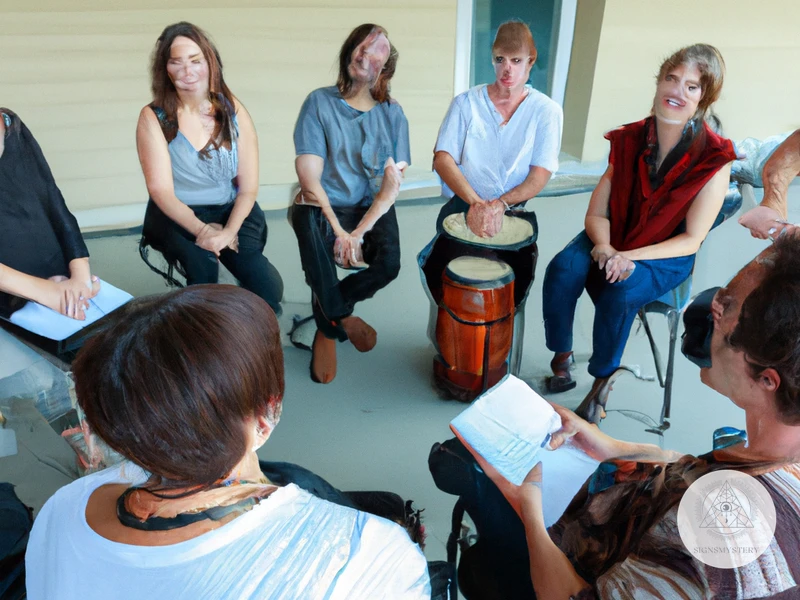
The purpose of your drum circle can determine the direction and outcome of the experience. First, ask yourself if you want to focus on community building or spiritual connection. A focus on community building may involve creating a fun and casual atmosphere for people to come together, make music, and connect with one another. Spiritual connection, on the other hand, may have a deeper intention to foster healing, personal growth, and shamanic journeying.
Next, consider the intended outcome of your drumming circle. Are you looking to simply have fun and enjoy the rhythms, or are you hoping to create a space for personal growth and transformation? Determining your purpose can help you choose the appropriate rhythms and plan for the right atmosphere.
It’s also important to choose a time and place that works for your participants. Keep in mind that a drum circle can be quite noisy and may not be appropriate for certain locations or times of day. Consider a location that is accessible and comfortable for all participants.
If you’re interested in shamanic drumming, you can check out our article about shamanic drumming rhythms and tempo. This article can provide insight into creating a deeper spiritual connection through your drumming.
Do you want to focus on community building or spiritual connection?
When starting a drum circle in your community, it’s important to determine your purpose and what you hope to achieve through the drumming. One of the first questions to ask is, “Do you want to focus on community building or spiritual connection?” Both options can be equally important and fulfilling, but it’s important to decide which one will be the primary focus of your drumming circle.
Community Building: If you want to focus on community building, your intention is to create a space where people can come together, connect, and enjoy music. The rhythm becomes the common thread that unites the participants, helping them to feel a sense of togetherness and belonging.
To focus on community building, consider the following tips:
- Create a welcoming and inclusive environment where everyone feels comfortable and valued.
- Encourage everyone to participate, regardless of their musical experience or ability.
- Choose energetic and uplifting rhythms that get people moving and grooving.
- Consider incorporating other activities such as dance or movement to enhance the sense of community.
Spiritual Connection: If you want to focus on spiritual connection, your intention is to use the drumming circle as a tool for personal and collective transformation. The drum becomes a vehicle for journeying within and connecting with the divine.
To focus on spiritual connection, consider the following tips:
- Create a sacred space where participants feel safe and supported to explore their inner selves.
- Encourage everyone to approach the drumming with intention, setting personal goals for the experience.
- Choose rhythms and songs that are conducive to introspection and meditation.
- Consider incorporating other spiritual practices such as visualization or guided meditation to enhance the connection.
Deciding whether to focus on community building or spiritual connection is a crucial step in starting your drum circle. It will define the intention of your circle and help guide your choice of rhythms, facilitation style, and overall approach. Both options can bring valuable benefits to your participants, so choose the one that resonates with you and your community the most.
If you’re interested in learning more about the spiritual aspects of drumming circles, check out the intention-setting and symbolism of shamanic drumming. On the other hand, if you’re looking for practical tips on how to run a successful drum circle, check out our article on successful drum circle tips.
What is the intended outcome of your drumming circle?
One of the important factors in creating a successful drumming circle is determining what the intended outcome will be. Different drum circles have different goals, whether that be community building, spiritual connection, or even therapeutic benefits. It is important to have a clear understanding of the intended outcome in order to create a cohesive and meaningful experience for all participants.
If your main goal is community building, the drumming circle should be open and welcoming to all members of the community. The drumming circle can serve as a space for people to come together, share their experiences, and connect over the shared love of music. By providing a positive and inclusive environment, the drumming circle can help to bring individuals from different backgrounds together in a meaningful way.
On the other hand, if your primary focus is on spiritual connections, you may want to create a drumming circle that incorporates shamanic practices. This can include using a specific type of drum, such as a shamanic drum, or incorporating specific rituals or symbolism into the circle. This type of drumming circle can help individuals to connect with their spiritual side, and find a deeper sense of meaning and purpose.
Ultimately, the intended outcome of your drumming circle will depend on your specific goals and the needs of your community. By taking the time to consider the desired outcome and plan accordingly, you can create a drumming circle that is both meaningful and impactful for all who participate.
Choose a time and place that works for your participants
When choosing a time and place for your drumming circle, it’s important to consider the needs of your participants. You’ll want to choose a time when people are available and a location that is easy to access.
Here are some factors to keep in mind:
| Factor | Consideration |
|---|---|
| Time of Day | Consider when people are available. Evening hours may work well for those who work during the day. You may also want to consider weekend afternoons when people are more likely to be free. |
| Location | Choose a location that is easy to access. A park or community center may be a good option. |
| Weather | Consider the weather when choosing a time and location. If it’s too hot or too cold, participants may be uncomfortable. |
| Acoustics | Choose a location with good acoustics. A space with a lot of echo may make it difficult to hear the rhythms. |
Keep in mind that you may need to be flexible with your schedule and location to accommodate the needs of your participants. Consider sending out a survey or asking for input from participants to help narrow down the best time and location for your drumming circle.
Now that you’ve chosen a time and place for your drumming circle, it’s time to start reaching out to your community to get the word out and find potential participants. You can use social media or community bulletin boards to advertise your event. Don’t forget to reach out to local organizations, churches, or community centers to find potential participants as well.
Step 2: Reach Out to Your Community
Once you have a clear purpose for your drum circle, it’s time to start reaching out to your community to find potential participants. There are various ways you can do this, both online and offline.
Use social media or community bulletin boards to advertise your event
One effective way to reach a large audience is through social media. Create a social media page or event for your drumming circle and invite people within your community to attend. Share this page on other pages focused on community events or on community bulletin boards. Consider using Facebook, Twitter, and Instagram to promote your event. Make sure your event posts contain high-volume keywords related to drum circles and community building.
Reach out to local organizations, churches, or community centers to find potential participants
Another great way to find participants is by networking with local organizations, churches, or community centers. You can email or call them and ask if they would be interested in participating or promoting the event. Explain the purpose of your drum circle and the benefits of community drumming. If they are willing to promote or participate in your event, you can ask for them to share your social media page or event on their website or bulletin board.
Remember to be respectful in your communications and make it clear that your drum circle is open to anyone who wants to participate, regardless of their religious or spiritual background. By promoting your drum circle in a respectful and inclusive way, you can attract a diverse group of people with different backgrounds, ages, and interests.
Make sure to use these outreach methods to get as many potential participants as possible informed about your drumming circle. By connecting with your community, you can spread the word and get people excited about this unique opportunity.
Stay tuned for the next step, which will cover planning your drum circle and ensuring that it runs smoothly. And if you’re interested in learning more about the symbolism and spiritual significance of drum circles, check out our article on Shamanic Drum Circle Symbolism.
Use social media or community bulletin boards to advertise your event
When it comes to advertising your drum circle event, social media and community bulletin boards can be invaluable resources. By utilizing these tools, you can easily reach out to potential participants and build a sense of community around your event.
Social Media: Social media platforms such as Facebook, Twitter, and Instagram can be particularly effective in promoting your drum circle event. Begin by creating a post that highlights the date, time, and location of the event. Be sure to use relevant hashtags such as #drumcircle or #communitydrumming to increase visibility and reach a wider audience.
You can also create a Facebook event page to share more detailed information about your drum circle. This page can include a description of the event, photos, and information about the type of drums and percussion instruments that will be provided. Encourage interested individuals to RSVP and share the event with their friends.
Community Bulletin Boards: Community bulletin boards can be found in a variety of locations such as libraries, coffee shops, and community centers. Create a poster that includes the date, time, and location of the event, as well as any additional information such as the intended purpose of the drum circle. Be sure to include contact information or a way for interested individuals to learn more about the event.
You can also reach out to local organizations such as churches, schools, or community centers to see if they have a bulletin board or newsletter where you can promote your drum circle event. This can be a great way to reach individuals who may be interested in participating but may not be active on social media.
Tips for Advertising:
- Be sure to start advertising your event at least a week or two in advance to give potential participants enough time to plan.
- Use eye-catching graphics or photos to make your posters and social media posts stand out.
- Consider partnering with a local business or organization to help promote your event.
- Encourage participants to bring friends or family members to help grow your community drumming circle.
By utilizing social media and community bulletin boards, you can effectively promote your drum circle event and build a community around your shared love of drumming.
Reach out to local organizations, churches, or community centers to find potential participants
If you’re looking to create a drum circle in your community, it’s crucial to reach out to local organizations, churches, or community centers to find potential participants. These venues are often interested in hosting events and activities that bring people together, making them the perfect place to advertise your drum circle.
Start by contacting local churches and community centers. You can approach them in person, over the phone, or via email. Introduce yourself and explain that you are looking to create a drum circle in the community. Outline the benefits of community drumming and why it would be a great fit for their organization.
Be sure to emphasize that drumming circles are not exclusive to any particular religious or spiritual belief. They are open to anyone who wants to participate and have fun.
At the same time, you can also use social media to advertise your event. Create an event page on Facebook and share it with your local community. You can also post on community bulletin boards to reach out to people who might be interested in joining.
Reaching out to local organizations, churches, or community centers is a great way to find potential participants for your drumming circle. Be sure to highlight the benefits of community drumming and encourage people from all walks of life to participate in the fun.
Step 3: Plan Your Circle
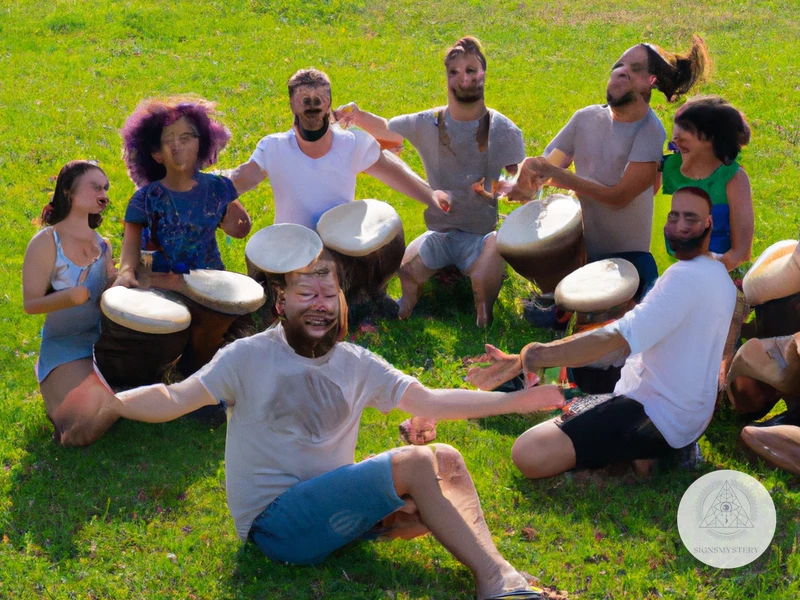
Now that you have determined your purpose and reached out to potential participants, it’s time to plan your drumming circle. Proper planning will make your event run smoothly and ensure that everyone has a positive experience. Here are some things to consider when planning your drum circle:
Gather Your Drums and Percussion Instruments
The type of drums and percussion instruments you use will depend on the style of music you want to play. Traditional African drumming circles typically use djembes, congas, and other hand percussion instruments. If you want to incorporate other styles of music, such as Latin or Middle Eastern rhythms, you may need to include other instruments like bongos or frame drums.
It’s best to have a variety of instruments available for participants to use. If you don’t have enough drums, consider asking participants to bring their own or using other household items as percussion instruments, such as buckets or pot lids.
Create a Plan for Facilitating
Facilitating a drum circle involves keeping the group focused, leading transitions between rhythms, and making sure everyone is included. If you’re not an experienced facilitator, it’s a good idea to take a workshop or work with someone who is.
When planning your circle, consider ways to keep the energy level high and encourage active participation. Some facilitation techniques you can use include call and response patterns, group chants, and changing up the dynamics of the music by adding or subtracting instruments.
Choose and Learn Traditional Rhythms or Create Your Own
If you’re interested in playing traditional rhythms, consider studying the rhythms of West Africa, Cuba, or Brazil. There are many resources available online, such as instructional videos and sheet music, to help you learn these rhythms.
If you prefer to create your own rhythms, experiment with different patterns and see what works. Start with a simple rhythm and build on it. The key is to keep the beat steady and repetitive, so participants can easily join in.
To summarize, planning your drumming circle is essential for a successful event. Gather your drums and percussion instruments, create a plan for facilitating, and choose and learn traditional rhythms or create your own. These steps will help you create an engaging and meaningful drumming circle for your community.
Gather your drums and percussion instruments
One of the most essential steps in starting a drum circle is gathering the necessary instruments. You can reach out to your community and ask for participants to bring their own percussion instruments or purchase some yourself. Some common instruments used in a drum circle include:
- Djembes: A skin-covered drum originating from West Africa. Available in different sizes and pitches, a djembe is usually played with bare hands
- Ashikos: A drum originating from Africa, with a narrow base and wide mouth. Similar to a djembe, it is also played with bare hands
- Bongos: A pair of small drums originating from Cuba, played with the hands. Bongos have a higher pitch than djembes and ashikos, and are great for adding variety to the rhythm
- Congas: A tall, narrow drum originating from Cuba, played with hands or sticks. Congas produce a deep, rich tone that provides a strong foundation for the rhythm
- Tambourines: A handheld percussion instrument with small jingles around the edge. Tambourines are great for adding rhythm and texture to the overall sound
- Shakers: Small percussion instruments that create a rhythmic shaking sound. They’re available in different shapes and sizes, and can be handmade or purchased
It’s important to have a variety of instruments available to allow for different sounds and rhythms. You can also encourage participants to bring their own instruments, ensuring everyone has something to play.
If you’re purchasing instruments, look for quality and affordability. You can find affordable drums and percussion instruments online or at music stores. Additionally, consider purchasing a set of spare drumsticks or mallets in case anyone forgets to bring their own.
Create a plan for facilitating
Creating a plan for facilitating your drum circle is an essential step towards a successful event. Here are some things to consider when creating your plan:
- Outline the structure: Decide how long the circle will last, how many rhythms you will play, and when breaks will be taken. This will help keep everyone on track and ensure that you cover everything you planned.
- Set ground rules: Establish some guidelines to help keep the focus on the music and maintain a positive experience for all. For example, ask participants to refrain from talking during the circle or to avoid using their phones.
- Encourage participation: Make sure everyone feels welcome and included in the circle. Consider using call and response patterns or simple rhythms to get everyone involved, regardless of their level of experience.
- Be flexible: While it’s important to have a plan, it’s also important to be able to adapt to the needs of your participants. Allowfor spontaneity and encourage creativity.
Subscribe to Our Newsletter
Sign up to receive the latest news and updates.
- Provide guidance: Offer guidance and instruction to anyone who needs it, but avoid being overbearing. Remember that the goal is to create a fun and welcoming space for everyone to enjoy the music.
- Close the circle: End the circle with a simple rhythm or song that everyone can play together. Use this as an opportunity to reflect on the experience and express gratitude.
By creating a plan for facilitating your drum circle, you can help ensure that everyone has a positive and enjoyable experience. Remember to be flexible and open-minded while facilitating, and encourage participation from everyone in the circle.
Choose and learn traditional rhythms or create your own
When it comes to choosing and learning traditional rhythms for your drum circle, there are many options to consider. Traditional rhythms can vary depending on cultural heritage or geographic location. Some popular traditional rhythms include:
| Afro-Cuban: | rhythm patterns like the bata, rumba, and conga |
| African: | rhythms like djembe, ashiko, and dunun |
| Native American: | rhythms like the heartbeat, turtle, and crow |
It can be helpful to research the history and cultural significance behind each rhythm, as this can enhance the experience for your participants. Additionally, you may consider creating your own rhythms to bring a unique flavor to your drum circle. To create your own rhythms, start by experimenting with different beats and playing around with tempo and dynamics. You can also consider incorporating other instruments or vocal elements into your rhythm.
It’s important to keep in mind that regardless of the rhythm you choose, the overall goal is to create a sense of cohesion amongst your participants and facilitate a shared experience through rhythm and music. Encourage your participants to join in and have fun regardless of prior experience or skill level.
Step 4: Host Your First Circle
Hosting your first drum circle can be a rewarding experience for both you and your participants. Here are some tips to ensure that your event goes smoothly:
Prepare the space and set up instruments:
Choose a location: Consider an outdoor space, such as a park or beach, as it provides ample space for drumming and fresh air. Ensure that your chosen location has restrooms nearby and adheres to any community noise regulations.
Set up the instruments: Make sure all your drums and percussion instruments are in good working condition. Arrange them in a circle, creating a comfortable and accessible space for your participants.
Introduce yourself and provide some background information on drum circles:
Greet your participants: Welcome everyone to the circle and introduce yourself. Encourage your participants to introduce themselves, if they feel comfortable doing so. This creates a sense of community and connection.
Provide some background information: Inform your participants about the history and purpose of drum circles. Share your personal experience and passion for drumming. This helps to create a deeper understanding and appreciation for the event.
Begin with a simple rhythm, allowing everyone to join in:
Choose a simple rhythm: Start by selecting a simple rhythm that everyone can easily follow. Some popular rhythms include the heartbeat rhythm, the call-and-response rhythm, and the three-beat rhythm. Look online for examples or create your own.
Allow everyone to join in: Encourage everyone to join in by playing the selected rhythm. Allow for mistakes and improvisation, as this creates a unique and inclusive experience.
Hosting your first drum circle requires preparation, communication, and a passion for drumming. Remember to have fun, connect with your community, and share the benefits of community drumming.
Prepare the space and set up instruments
Preparing the space and setting up instruments are important steps to ensure a successful drumming circle. Here are some tips to make the process smoother:
Prepare the space:
1. Choose a location that is quiet and peaceful. A space with natural surroundings can be a great atmosphere for drumming.
2. If possible, lay down some blankets or rugs to sit on.
3. Make sure the space is free of any obstacles or hazards.
4. Consider the weather conditions. If it is too hot, consider having the drumming circle in a shaded area. If it’s raining or too cold, make plans to move indoors.
Set up the instruments:
1. Gather all the drums and percussion instruments you have collected. Some popular instruments include djembes, congas, bongos, tambourines, shakers, and maracas.
2. Place the instruments in a way that allows easy access for all participants.
3. Tune the drums and percussion instruments before the drumming circle begins. This ensures that the music sounds harmonious and the rhythm is in sync.
4. Consider having extra instruments available for guests who may not have brought their own.
5. Provide some basic instruction on how to handle and play the instruments for those who are new to drumming.
By preparing the space and setting up the instruments properly, you create a welcoming and comfortable atmosphere for all participants, ensuring that they have an enjoyable drumming experience.
Introduce yourself and provide some background information on drum circles
When you host your first drum circle, it’s essential to introduce yourself and provide some background information on the activity. These introductory remarks help set the tone for the event and establish your leadership role.
Introduce yourself and welcome everyone to the circle. You can share your name and a brief explanation of your experience with drum circles. Don’t feel the need to oversell yourself, but do let the participants know that you have some knowledge and experience in facilitating these types of events.
Next, provide some background information on drum circles. Share that drum circles have been part of human culture for thousands of years in different communities and for different purposes. You can explain that drumming is a universal language and that it’s a way to communicate and connect with others without using words.
You can also share the benefits of drumming, such as reducing stress, improving mood, and promoting relaxation. You can also mention that the goal of the drum circle is not to perform but to create a rhythm together, regardless of skill level or previous experience.
It’s important to emphasize that the drum circle is a judgment-free space. Encourage everyone to participate, regardless of their musical skill level. Let participants know that there is no right or wrong way to drum and that everyone’s contribution is important.
Make sure to answer any questions that participants may have about the event or drumming in general. You may want to ask if anyone has any previous experience with drumming or if they have any injuries or physical limitations that may affect their ability to participate.
By introducing yourself and providing background information on drum circles, you can create a welcoming environment that fosters community and connection. Remember to emphasize the inclusivity and non-judgmental nature of the event and encourage participants to have fun and enjoy the experience.
Begin with a simple rhythm, allowing everyone to join in
Beginning with a simple rhythm is essential to ensure that everyone can participate and feel comfortable. A good starting point is the “heartbeat rhythm,” which is a simple and universally recognized rhythm that mimics the sound of a beating heart. To play the rhythm, everyone should follow the beat of the facilitator or the lead drummer.
Here are some steps to follow when beginning with a simple rhythm:
| 1. | Teach the rhythm by breaking it down into easy-to-learn parts. Start with the bass drum, which is played with the dominant hand on the center of the drum. The dominant hand is the one you use to write or throw a ball. The other hand should play the tone, which is a higher-pitched sound made by hitting the edge of the drum with the other hand. |
| 2. | Once everyone has a handle on playing the bass and tone, add in the slap. The slap is made by striking the drum with the fingers of either hand, and it creates a sharp, popping sound. |
| 3. | Repeat the rhythm several times until everyone has a solid grasp on it. Encourage participants to experiment with adding their own variations to the rhythm. |
As the group becomes more comfortable with the basic rhythm, you can add more complex rhythms to your repertoire. It’s important to keep the rhythm simple and allow participants to build their skills over time. Be patient and supportive, and celebrate each person’s progress.
Remember that the point of the drum circle is to bring people together, have fun, and create a shared experience. By beginning with a simple rhythm and allowing everyone to join in, you’re creating a space that’s inclusive and welcoming. This will help to build confidence and encourage people to keep coming back to your drum circle.
Conclusion
In conclusion, starting your own drum circle can be a fulfilling and enjoyable experience for you and your community. By following these steps, you can create a space for people to connect, express themselves, and find inner peace through the joy of music-making.
Determine your purpose: Before you start your drum circle, it’s important to consider your purpose. Do you want to focus on community building or spiritual connection? What is the intended outcome of your drumming circle? Answering these questions will help you create a clear plan for your circle.
Reach out to your community: Once you know your purpose, it’s time to reach out to your community. Use social media or community bulletin boards to advertise your event. Reach out to local organizations, churches, or community centers to find potential participants. The more people you can involve, the more vibrant and engaging your drum circle will be.
Plan your circle: Gather your drums and percussion instruments, create a plan for facilitating, and choose and learn traditional rhythms or create your own. Having a plan in place will help your drum circle run smoothly and ensure that everyone has a great time.
Host your first circle: When hosting your first circle, make sure to prepare the space and set up instruments. Introduce yourself and provide some background information on drum circles. Begin with a simple rhythm, allowing everyone to join in and get comfortable. This will help build a sense of community and make everyone feel welcome.
Recap the steps: Starting a drum circle may seem overwhelming at first, but by following these steps, you’ll be well on your way to creating a successful and enjoyable experience for everyone involved. Remember to determine your purpose, reach out to your community, plan your circle, and host your first circle with confidence and enthusiasm.
Highlight the benefits: Drumming circles can have a profoundly positive impact on communities. They can help reduce stress, promote relaxation, and foster a sense of belonging and connection. Through the power of rhythm and music, people can come together in joy and harmony. So, don’t hesitate to start your own drum circle and reap the benefits of community drumming.
Recap the steps and highlight the benefits of community drumming
Recap the steps and highlight the benefits of community drumming:
Starting your own drum circle can be an incredibly rewarding experience that brings people together and fosters a sense of community. Here is a recap of the key steps to follow:
| Step 1: | Determine your purpose. |
| Step 2: | Reach out to your community. |
| Step 3: | Plan your circle. |
| Step 4: | Host your first circle. |
Community drumming offers a range of benefits for individuals and groups alike. Here are just a few ways that drumming circles can positively impact people:
- Reduces stress and anxiety: Drumming is known to lower cortisol levels and help people relax.
- Fosters community: Drum circles provide a space for people to connect and collaborate, which can help to build stronger communities.
- Promotes mindfulness: Drumming requires focus and attention, which can help to cultivate a sense of mindfulness and presence.
- Boosts creativity: Playing music can spark creativity and offer a new outlet for self-expression.
- Provides a sense of accomplishment: Learning a new rhythm or instrument and contributing to a group performance can be highly satisfying and rewarding.
Starting a drum circle in your community can be a fun and meaningful way to bring people together and promote a sense of unity. By following these steps and reaping the benefits of community drumming, you can create a positive and enriching experience for yourself and others.
Frequently Asked Questions
1. Do I need to be a professional drummer to start a drum circle?
No, anyone can start a drum circle! You just need to have a passion for drumming and a desire to bring your community together.
2. Where is the best place to host a drum circle?
You should choose a location that is easily accessible and has enough space for participants to comfortably sit in a circle with their instruments.
3. What kind of drums and percussion instruments should I use?
You can use any kind of drum or percussion instrument, from djembes to shakers and bells. Encourage participants to bring their own instruments if they have them.
4. Can children participate in a drum circle?
Absolutely! Drumming is a great activity for children of all ages, as it helps with coordination and rhythm, and provides a fun way to express themselves.
5. How long should a drum circle last?
Typically, a drum circle lasts around an hour. However, you can adjust the length to fit the needs of your participants.
6. Should I have a set rhythm or allow for improvisation?
Both are valid options! If you choose to have a set rhythm, make sure to teach it to the group beforehand. If you want to allow for improvisation, create a simple “groove” that everyone can follow.
7. Do I need to provide refreshments or snacks?
It’s not necessary, but providing water or light snacks can add to the community-building aspect of the drum circle.
8. What is the ideal number of participants for a drum circle?
Anywhere from 5 to 20 participants is a good size for a drum circle, but you can have more or less depending on your preference.
9. How often should I host a drum circle?
You can host a drum circle on a weekly, monthly, or even quarterly basis depending on your availability and the interest of your participants.
10. Can I incorporate other activities or rituals into my drum circle?
Yes! You can incorporate movement, singing, or even setting intentions for the circle. Just make sure to communicate any additional activities beforehand so that participants know what to expect.



